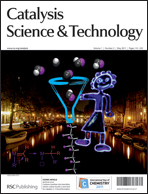A water-soluble phosphite derived from sulfonated calix[4]arene. The remarkable stability of its rhodium complexes and two phase hydroformylation studies
Abstract
The reaction of tetrasulfonated calix[4]arene (trioctylammonium salt) with P(NMe2)3 followed by treatment with gaseous NMe2H gave a zwitterionic six-coordinate phosphorus(V) species 1 containing a P(H)(NHMe2) group which can be stored for months without
![Graphical abstract: A water-soluble phosphite derived from sulfonated calix[4]arene. The remarkable stability of its rhodium complexes and two phase hydroformylation studies](/en/Image/Get?imageInfo.ImageType=GA&imageInfo.ImageIdentifier.ManuscriptID=C0CY00031K&imageInfo.ImageIdentifier.Year=2011)

 Please wait while we load your content...
Please wait while we load your content...